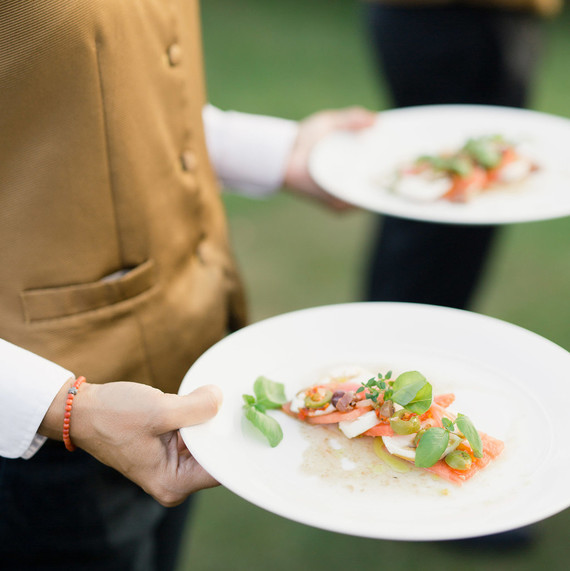Your choice of catering depends on the atmosphere of the venue, your style and so the style of the wedding itself, the number and composition of the guests invited, and your preferred gastronomical tastes. To help you decide, we have compiled a list of the most typical forms of catering, including their characteristics, both positive and negative, for you to weigh up.

Served dinner
The classical form of the served dinner usually consists of four courses, starter, soup, a choice of two or three mains, and dessert. Within this, there is a distinction between plated and platter service resulting in differences in method and form of service, and in appearance.
Advantages:
- In the case of plated service foodies will be able to enjoy a gastronomical experience as there are many possibilities for a richer, more colourful, more detailed and more aesthetic use of ingredients, and opportunities for presentation.
- It is easier to cater for one or two guests with special dietary requirements
- The quantity of food can be estimated more accurately so less food is wasted.
Disadvantages:
- Plated service is more expensive than the other forms of catering. You have to calculate not only with the cost of the food but also with high waitering costs.
- If the staff is not sufficient for the number of guests, there can be a big delay until the last table receives their food.
- The number of dishes to choose from can be limited, so this form of catering is more suitable for smaller weddings.
- In the case of plattered service, the platters placed on the tables may disrupt the decorations
Buffet service
Buffet service is deservedly one of the most widespread and favoured forms of catering. Its high rating is due to the fact that suitable courses can be found to cater for many tastes, diets and lifestyles, and guests can spend forever picking and choosing. There are two types of buffet, one where the staff of the catering service serve the food, the other which operates on a self-service system.
Advantages:
- Considerably fewer staff are required compared to the served dinner.
- The guests are offered a wider range of food
- There is the possibility to sneak in some specialities which only a few people like beside the more mainstream courses
- Ideal for a big number of guests
- Perfect solution for weddings where different nationalities are on the guest list, as everyone can find something to their liking.
Disadvantages:
- The quality of the food may decline if it is out for a long time, and not properly stored
- The price often does not include the assisting staff which means extra cost
- Long queues at the food stations may lengthen the duration of the dinner
- You have to calculate with much bigger quantities, and therefore extra cost, as everyone tends to have an eye bigger than their stomach when helping themselves at the buffet!
- The buffet covers a bigger area of the venue space
Served dinner and buffet combination
In many peoples’ opinion, this is the best catering option for bigger weddings. In this case, the starter, and or soup is served at table, and the guests take the other courses from the buffet.
Advantages:
- The starters present the opportunity to offer culinary bites to the guests
- All the disadvantages connected to the served dinner can be avoided while enjoying all the advantages of the buffet
Disadvantages:
- The same problems may arise as can occur at any separated serving method
Fingerfood, aperitivo
The word “aperitivo” means for the Italians a kind of “pre-dinner”, closely connected to the Spanish tapas or the American happy hour traditions. It can take the form of a welcome for guests on arrival, or in the case of a smaller affair, it can be the perfect option to offer the guests some gourmet bites if you would prefer to avoid organizing a big dinner.
Advantages:
- You can avoid one of the biggest expenses of a wedding, the classical dinner
- Guests can enjoy many dainty morsels and little culinary treats without feeling uncomfortably full
- You can choose from a great selection of tastes, you are not limited to choosing from 2-5 main dishes
- An ideal solution if you hold the civil ceremony with a few guests before the party
- As the guests are not separated into groups of 8-10 around a table, more conversation is generated
- If there is no kitchen in your chosen venue, and the location would be a challenge for the most experienced catering company, it may be an ideal solution to offer finger food only.
- Not only giant portions are delicious and filling!
Disadvantages:
- Does not replace a complete evening dinner in itself
- Not perfect for large numbers of guests
- The ingredients used to make finger food are often more expensive
Food truck and grilling
The food truck certainly takes us back a few years in time, but still offers an alternative form of wedding catering, which is impossible to get bored with. It can be put virtually anywhere and adds a colourful splash to the wedding dinner.
Grilling also adds colour to the wedding, and its popularity is proven by the fact that the longest queue of guests will be found at the grill, rather than the buffet.
Advantages:
- Super dinner in a friendly atmosphere, for a not too big wedding
- Lovers of street food will find everything their heart desires
- Guests can enjoy an unusual selection of food
- Not too many infrastructure problems regarding the placing of the food truck
- The very spectacle adds to the wedding atmosphere
Disadvantages:
- In the case of a large number of guests, preparing the freshly fried food can take time, causing a long queue at the counter




Food truck: Tütü Gaszto Busz, Photo: Petra Pako


























